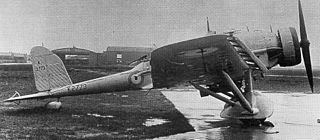
The Avro Type E, Type 500, and Type 502 made up a family of early British military aircraft, regarded by Alliott Verdon Roe as his firm's first truly successful design. It was a forerunner of the Avro 504, one of the outstanding aircraft of the First World War.

The Blackburn Type D, sometimes known as the Single Seat Monoplane, was built by Robert Blackburn at Leeds in 1912. It is a single-engine mid-wing monoplane. Restored shortly after the Second World War, it remains part of the Shuttleworth Collection and is the oldest British flying aeroplane.

The Handley Page Type G was a two-seat British biplane, designed by Handley Page that first flew in 1913. Only one was built.
The Avro Burga was built by Avro for R.F. Burga to test his unique system of lateral control. It was a single-engined two-seat monoplane, fitted with differentially operated surfaces above and below the central fuselage.
The Handley Page H.P.22 and H.P.23 were single-seat sport monoplanes produced for the 1923 Lympne light aircraft trials. They were not successful.

The Handley Page H.P.43 was a three-engined biplane bomber-transport built to an Air Ministry specification. It did not fly well and the biplane configuration was out-dated at completion; the only one constructed was later turned into a monoplane and led to the Handley Page H.P.54 Harrow.
The Handley Page H.P.46 was a two-seat, single-engined biplane built to an Air Ministry specification for a carrier-based torpedo bomber. With an advanced combination of high lift, slow flying controls it was beset by handling problems and made few flights.

The Handley Page H.P.47 was a British single-engined low-wing monoplane built to an Air Ministry specification for a general-purpose bomber and torpedo bomber aircraft. Only one was built.

The Handley Page Type E was a two-seat, single-engined monoplane intended as a demonstrator. Though only one was built, it flew successfully from 1912 to 1914, carrying several hundred passengers and flying several thousand miles.

The Short S.41 was a British single-engined biplane built for the Royal Navy in 1912. Capable of being operated either on wheels or floats, it was successful enough for a further two similar aircraft to be built, with the type remaining in use until the early years of the First World War.
The Short S.45 — also known as the Short T.5 after its naval serial number — was a training biplane built for Britain's Royal Navy by Short Brothers in 1912. It was the forerunner of another three identical aircraft delivered to the Royal Navy and Royal Flying Corps during 1912 and 1913. The Royal Naval Air Service was still operating the type when World War I broke out in 1914.

The Dunne D.8 of 1912 was a tailless swept wing biplane, designed by J. W. Dunne to have inherent stability. One example was supplied to RAE Farnborough. License-built Burgess-Dunne models were used by the US Signal Corps and United States Navy and the short-lived Canadian Aviation Corps. It was the latter's first and only warplane.

The ASL Viking was a single-engined two seater biplane aircraft designed and built by Horatio Barber's Aeronautical Syndicate Ltd. at Hendon. It was first flown in January 1912.

The Short S.36 was a British two-seat tractor biplane, built by Short Brothers for Francis McClean in 1911. It was later developed into the Short S.41 and Short S.45, which were the first of a long series of similar aircraft built for the RNAS and RFC.
The Bristol-Burney seaplanes were a pair of experimental seaplanes produced by a collaboration between Lt. Dennistoun Burney and the Bristol and Colonial Aeroplane Company during 1912–14. The aircraft, neither of which was successfully flown, featured a novel hydroplane undercarriage. Although not a success, their development was the basis of Burney's later invention of the paravane.

The Gabardini monoplane was a successful early monoplane constructed in Italy which made several notable flights, often carrying passengers, just before World War I. During the war, a number of lower-powered Gabardini monoplanes served as a training aircraft for the military.

The Ponnier D.III was a French monoplane racing aircraft, designed to compete in the 1913 Gordon Bennett Trophy race. It finished a close second.

The Hanriot D.I was a French monoplane racing aircraft, designed in France in 1912 and strongly influenced by Nieuport practice. Examples were built and raced both in France and the UK during 1912.

The Blériot XXI was an early French aircraft built by Blériot Aéronautique.

The Caudron Types M and N were small, fast French sports monoplanes, flown 1911–13 under a wide range of engine powers. There was also a military version.















